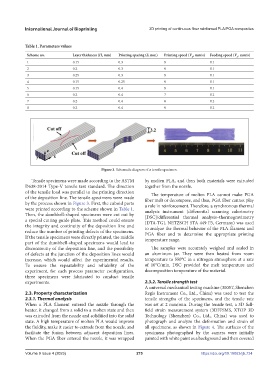Page 283 - IJB-9-4
P. 283
International Journal of Bioprinting 3D printing of continuous fiber reinforced PLA/PGA composites
Table 1. Parameters values
Scheme no. Layer thickness (H, mm) Printing spacing (S, mm) Printing speed (V , mm/s) Feeding speed (V , mm/s)
p
f
1 0.15 0.3 9 0.1
2 0.2 0.3 9 0.1
3 0.25 0.3 9 0.1
4 0.15 0.25 9 0.1
5 0.15 0.4 9 0.1
6 0.2 0.4 7 0.2
7 0.2 0.4 8 0.2
8 0.2 0.4 9 0.2
Figure 3. Schematic diagram of a tensile specimen.
Tensile specimens were made according to the ASTM by molten PLA, and then both materials were extruded
D638-2014 Type-V tensile test standard. The direction together from the nozzle.
of the tensile load was parallel to the printing direction The temperature of molten PLA cannot make PGA
of the deposition line. The tensile specimens were made fiber melt or decompose, and thus, PGA fiber cannot play
by the process shown in Figure 3. First, the cuboid parts a role in reinforcement. Therefore, a synchronous thermal
were printed according to the scheme shown in Table 1. analysis instrument (differential scanning calorimetry
Then, the dumbbell-shaped specimens were cut out by [DSC]/differential thermal analysis–thermogravimetry
a special cutting guide plate. This method could ensure [DTA-TG], NETZSCH STA 449 F3, Germany) was used
the integrity and continuity of the deposition line and to analyze the thermal behavior of the PLA filament and
reduce the number of printing defects of the specimens. PGA fiber and to determine the appropriate printing
If the tensile specimens were directly printed, the middle temperature range.
part of the dumbbell-shaped specimens would lead to
discontinuity of the deposition line, and the possibility The samples were accurately weighed and sealed in
of defects at the junction of the deposition lines would an aluminum jar. They were then heated from room
increase, which would affect the experimental results. temperature to 550°C in a nitrogen atmosphere at a rate
To ensure the repeatability and reliability of the of 10°C/min. DSC provided the melt temperature and
experiment, for each process parameter configuration, decomposition temperature of the material.
three specimens were fabricated to conduct tensile
experiments. 2.3.2. Tensile strength test
A universal mechanical testing machine (3005T, Shenzhen
2.3. Property characterization Regis Instrument Co., Ltd., China) was used to test the
2.3.1. Thermal analysis tensile strengths of the specimens, and the tensile rate
When a PLA filament entered the nozzle through the was set at 2 mm/min. During the tensile test, a 3D full-
heater, it changed from a solid to a molten state and then field strain measurement system (3DFFSMS, XTOP 3D
was extruded from the nozzle and solidified into the solid Technology (Shenzhen) Co., Ltd., China) was used to
state. A high temperature of molten PLA would improve photograph and analyze the deformation and strain of
the fluidity, make it easier to extrude from the nozzle, and all specimens, as shown in Figure 4. The surfaces of the
facilitate the fusion between adjacent deposition lines. specimens photographed by the camera were initially
When the PGA fiber entered the nozzle, it was wrapped painted with white paint as a background and then covered
Volume 9 Issue 4 (2023) 275 https://doi.org/10.18063/ijb.734

